Darrell K Royal–Texas Memorial Stadium
Darrell K Royal Memorial Stadium (formerly War Memorial Stadium, Memorial Stadium, and Texas Memorial Stadium), located in Austin, Texas, on the campus of the University of Texas, has been home to the Longhorns football team since 1924. The stadium has delivered a home field advantage with the team's home record through November 17, 2018 being 375–117–10 (.764).[1] The official stadium seating capacity is 100,119,[1] making the stadium the largest in the Big 12 Conference, the seventh largest stadium in the United States, and the ninth largest stadium in the world.
DKR Royal–Memorial Stadium Memorial Stadium | |
 | |
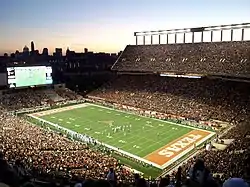 The stadium on the night of October 29, 2011 | |
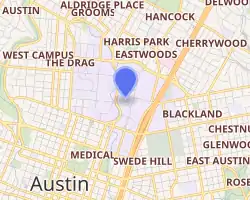 | |
| Former names | War Memorial Stadium (1924–1947) Memorial Stadium (1948–1976) Texas Memorial Stadium (1977–1995) |
|---|---|
| Location | 405 East 23rd Street Austin, Texas 78712 |
| Coordinates | 30.2836°N 97.7325°W |
| Operator | University of Texas at Austin |
| Capacity | 100,119[1] |
| Record attendance | 105,213 (Alabama Crimson Tide v. Texas Longhorns, September 10, 2022) |
| Surface | FieldTurf (2009–present) Natural grass (1996–2008) Artificial turf (1969–1995) Natural grass (1924–1968) |
| Construction | |
| Broke ground | April 4, 1924[2] |
| Opened | November 8, 1924 (first game) November 27, 1924 (dedication)[1] |
| Renovated | 1955, 1977, 1986, 1996, 2002, 2005, 2011, 2013 |
| Expanded | 1926, 1948, 1964, 1968, 1971, 1997–1999, 2006–2009, 2019–2021 |
| Construction cost | US$275,000[3] ($4.35 million in 2021 dollars[4]) North End zone Expansion US$149.9 Million South End zone Expansion US$200 Million |
| Architect | Herbert M. Greene |
| General contractor | Walsh and Burney[5] |
| Tenants | |
| Texas Longhorns (NCAA; 1924–present) | |
| Website | |
| texassports.com/texasmemorialstadium | |
The DKR–Texas Memorial Stadium attendance record of 105,213 spectators was set on September 10, 2022, when Texas played The University of Alabama (Texas 19-20 loss).
History
Memorial dedication
In 1923, former UT athletics director L. Theo Bellmont (the west side of the stadium is named in his honor), along with 30 student leaders, presented the idea to the Board of Regents of building a concrete stadium to replace the wooden bleachers of Clark Field. Heralded as "the largest sports facility of its kind in the Southwest" upon its completion in 1924, it seated 27,000 people in the lower level of the current facility's east and west grandstands. It was designed as a dual-purpose facility with a 440-yard (400 m) athletics track surrounding the football field. The stadium was financed through donations from both students and alumni. The estimated cost of the structure was $275,000.
The student body dedicated the stadium in honor of the 198,520 Texans—5,280 of whom lost their lives—who fought in World War I. A statue, representing the figure of democracy, was later placed atop the north end zone seats of the stadium. In World War II, the university lost many former players, including former coach Jack Chevigny. The Athletics Council rededicated the newly enlarged stadium on September 18, 1948, prior to the Texas-LSU game, honoring the men and women who had died in the war. On November 12, 1977, a small granite monument was unveiled and placed at the base of the statue, during the TCU-Texas game. The ceremony rededicated Texas Memorial Stadium to the memory of all alumni in all American wars.
The University of Texas honored legendary football coach Darrell K Royal, who enlisted in the US Army Air Corps in 1943, played at the University of Oklahoma under legendary Coach Bud Wilkinson, and who led Texas to three national championships and eleven Southwest Conference titles, by officially naming the stadium after him in 1996. Additionally, the university established the Royal-Texas Memorial Stadium Veterans Committee, composed of alumni who served in World War II, Korea, Vietnam, or the Gulf Wars. The committee is charged to forever dedicate the stadium in the memory of, and in honor of, UT students and alumni who gave their lives for their country. Each year, one home football game is designated as Veterans Recognition Day, commemorating the memorial aspect of the stadium and to honor the memory of war soldiers.
Renovations and expansions
The stadium has been expanded several times since its original opening.[6]
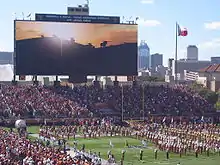
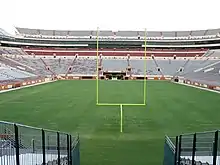

- 1926 – "Horseshoe" built on the north end for US$125,000 raising capacity to 40,500.
- 1948 – 26 rows were added to the east and west stands. Additionally, a section was added to the south end of the east and west stands. Capacity was raised to 60,136 at a cost of $1.4 million. General contractor for this work was Farnsworth & Chambers Inc. of Houston.
- 1955 – 8 100-foot Light towers were added at a cost of $200,000. First night game occurred on September 17, 1955.
- 1964 – Minor seating expansion added 780 seats, bringing capacity to 60,916.
- 1968 – Seating expansion added 5,481 seats, bringing capacity to 66,397.
- 1969 – Artificial turf, a tartan track and aluminium seats were installed. First game on turf occurred September 27, 1969
- 1971 – Upper deck added to the west side adding 15,990 seats, raising seating capacity to 77,809; General contractor for this work was a joint venture of two companies: Darragh & Lyda Inc. of San Antonio and H. A. Lott, Inc. of Houston.
- 1977 – Track converted from 440 yards to 400 meters (437.4 yds.).
- 1986 – The Vernon F. "Doc" Neuhaus–Darrell K Royal Athletic Center completed at the south end of the stadium at a cost of $7 million; the center was later renamed the W. A. "Tex" Moncrief, Jr.–V. F. "Doc" Neuhaus Athletic Center in 1997 after Royal's name was added to the stadium.
- 1989 – New four-color animated scoreboard was installed at the north end of the stadium
- 1996 – Replacement of the stadium's artificial turf with natural grass (Prescription Athletic Turf) at a cost of $1.25 million; installation of a Jumbotron video system; scoreboards retrofitted at a cost of $2.8 million. Stadium renamed Darrell K Royal–Texas Memorial Stadium to honor former Head Coach Darrell K Royal.
- 1997 – 14 stadium suites added to west side; underside of the stands remodeled, adding a concession plaza and visitors' locker room. In recognition of UT law school alumnus and benefactor Joe Jamail, the university named the football playing field Joe Jamail Field. Stadium capacity reduced by 2,297 seats, bringing capacity to 75,512.
- 1998 – Upper deck added to the east side including 52 new stadium suites and a 13,000-square-foot (1,200 m2) private club room. A total of 3,959 seats were added, bringing capacity to 79,471.
- 1999 – Track removed; new seats added to the west grandstand and the field was lowered seven feet to accommodate new front-row and field-level seats on the east and west grandstands, bringing capacity to 80,082.
- 2002 – TifSport Certified Bermuda grass replaced Prescription Athletic Turf. Cost $75,000
- 2005 – Bellmont Hall, located in the west side of the stadium, was upgraded to meet newer safety codes set by the Austin Fire Department, the upper deck structure received new water sealing, and the Centennial Room and eighth-floor press box were expanded at a cost of $15 million.
- 2006 – A 7,370-square-foot (685 m2) HD Daktronics LED scoreboard, nicknamed "Godzillatron", located in the south end zone, was installed as the centerpiece of $8 million worth of audio/visual improvements. At the time of its creation, it was called the largest HD video screen in the world,[7][8] though it was quickly surpassed by a larger screen in Tokyo.[9][10]The six large flag poles that previously displayed the Six Flags Over Texas were replaced by smaller flags located atop the new screen. The sound system was also updated and smaller video boards were installed on the east and west sides of the stadium. 432 club seats were added to the west side and approximately 4,000 bleacher seats were added behind the south end zone expanding official seating capacity to 85,123. Previously, two scoreboards were in place, one in the south end, the Freddie Steinmark Memorial Scoreboard and Jumbotron, and one in the north end, a video matrix screen. Both were removed after the 2005 season. The new scoreboard replaced the one in the south end. The north end no longer features a scoreboard as it was removed for the 2008 stadium expansion, the giant Longhorn symbol at the very top was sold on eBay.[11] On November 8, 2015, the UT Longhorns rededicated the scoreboard to Freddie Steinmark in a ceremony attended by many previous Longhorn players.[12]
- 2007–2008 – An expansion project costing US$149.9 million gave the stadium a new memorial plaza and new multi-level north end zone structure. The new outdoor plaza at the northwest corner is a memorial to veterans, with (the original 1924) bronze tablet honoring Texas World War I deaths, and a monument. The expansion included additional seats with an upper deck, club space, suites, athletic offices, academic-advising areas and a basement with gym space. Demolition of the old north end zone began on December 8, 2006, to move seating closer to the field.[13] The south end zone also became the new seating location of the Longhorn Band beginning in 2008. Overall, the stadium's official seating capacity increased to 94,113.[14]
- 2009 – A $27 million project[15] brought a new Football Academic Center, a new Hall of Fame, FieldTurf replaced the TifSport Certified Bermuda grass, and replaced the 4,000 south end temporary bleachers with the addition of 4,525 permanent bleacher seats bringing capacity to 100,119.[16]
- 2011 – Player locker room renovated with 135 new wide-space lockers connected to a state-of-the-art exhaust system, nutrition bar, lounge area with gaming stations, six large LED screens, and a new sound system and speakers.[1]
- 2013 – FieldTurf installed in 2009 replaced in April 2013 to improve drainage and change the orange in the end zones to more of a "burnt orange".[17]
- 2013 – A $62 million project[18] that will add a practice facility for the women's volleyball team in the basement of the north end zone as well as additional athletic offices. Bellmont Hall will receive facility improvements and become an academic center for kinesiology, health education and fine arts.[19]
- 2017 – Extensive upgrades to the locker room, weight room and meeting rooms. New LED video board in South End zone, ribbon boards and new sound system. West-side facade undergoes restoration and reinforcement.
- 2019–2021 – The final planned phase of the stadium's expansion includes construction of permanent seating in the south end zone, completely enclosing the playing field. Plans include club seating, luxury suites, and new video board. This plan has been part of the university's master plan since at least the early 1990s, as renderings and models of a fully enclosed stadium have existed since that time. On September 20, 2018, the university announced that it will spend $175 million on the south end zone project[20] with most of the funds coming from donations.[21] The south end zone will not mirror the north end zone and seating capacity has not been announced.[20] On May 4, 2019, ground was broken on the "south-end zone expansion project". "The new addition opened in time for the 2021 football season."[22]
- 2020 – In response to calls for increased diversity at the university and at the suggestion of the Jamail family, interim president Jay Hartzell announced that the field, previously named for Joe Jamail, would be renamed to honor Heisman Trophy winners Earl Campbell and Ricky Williams. Hartzell also announced that a statue of Julius Whittier, the school's first Black football letterman, would be erected at the stadium.[23][24]
- 2021 – New FieldTurf surface installed in time for the 2021 season at a cost of $429,906.[25][26]
Attendance record
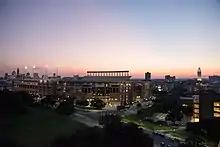
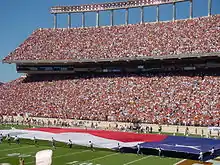
| Rank | Date | Opponent | Attendance | Score[27] |
|---|---|---|---|---|
| 1 | September 10, 2022 | #1 Alabama | 105,213 | L 19-20 |
| 2 | September 15, 2018 | #22 USC | 103,507 | W 37-14 |
| 3 | September 17, 2022 | UTSA | 102,520 | W 41–20 |
| 4 | November 17, 2018 | #18 Iowa State | 102,498 | W 24-10 |
| 5 | September 4, 2016 | #10 Notre Dame | 102,315 | W 50-47 (2OT) |
| 6 | October 6, 2012 | #8 West Virginia | 101,851 | L 45-48 |
| 7 | September 3, 2011 | Rice | 101,624 | W 34-9 |
| 8 | September 14, 2013 | #25 Ole Miss | 101,474 | L 23-44 |
| 9 | September 25, 2010 | UCLA | 101,437 | L 12-34 |
| 10 | November 21, 2009 | Kansas | 101,357 | W 51-20 |
| 11 | October 20, 2012 | Baylor | 101,353 | W 56-50 |
| 12 | September 11, 2010 | Wyoming | 101,339 | W 34-7 |
| 13 | September 19, 2009 | Texas Tech | 101,297 | W 34-24 |
| 14 | October 10, 2009 | Colorado | 101,152 | W 38-14 |
| 15 | September 26, 2009 | UTEP | 101,144 | W 64-7 |
| 16 | September 1, 2012 | Wyoming | 101,142 | W 37-17 |
| 17 | September 5, 2009 | Louisiana-Monroe | 101,096 | W 59-20 |
| 18 | September 7, 2009 | UCF | 101,003 | W 35-3 |
| 19 | September 10, 2011 | BYU | 100,995 | W 17-16 |
| 20 | September 8, 2012 | New Mexico | 100,990 | W 45-0 |
History of capacity changes
- 27,000 (1924–1925)
- 40,500 (1926–1947)
- 60,136 (1948–1963)
- 60,916 (1964–1967)
- 66,397 (1968–1970)
- 77,809 (1971–1996)
- 75,512 (1997)
- 79,471 (1998)
- 80,092 (1999–2005)
- 85,123 (2006–2007)
- 94,113 (2008)
- 100,119 (2009–2018, 2021–present)
- 95,594 (2019–2020) South End Zone seating removed for expansion project
See also
- List of NCAA Division I FBS football stadiums
References
- "DKR Memorial Stadium". University of Texas at Austin Department of Intercollegiate Athletics. July 24, 2013. Archived from the original on August 11, 2013. Retrieved August 6, 2013.
- Vanicek, Brian Allen; Creamer, Maureen L., eds. (1983). Commemorating The University of Texas Centennial. Vol. 90. The University of Texas at Austin: Texas Student Publications. Retrieved September 15, 2018.
- "DKR Memorial Stadium". Ballparks.com. Archived from the original on October 12, 2010. Retrieved December 11, 2010.
- 1634–1699: McCusker, J. J. (1997). How Much Is That in Real Money? A Historical Price Index for Use as a Deflator of Money Values in the Economy of the United States: Addenda et Corrigenda (PDF). American Antiquarian Society. 1700–1799: McCusker, J. J. (1992). How Much Is That in Real Money? A Historical Price Index for Use as a Deflator of Money Values in the Economy of the United States (PDF). American Antiquarian Society. 1800–present: Federal Reserve Bank of Minneapolis. "Consumer Price Index (estimate) 1800–". Retrieved April 16, 2022.
- Pennington, Richard (June 12, 2010). "DKR Memorial Stadium". Texas State Historical Association. Archived from the original on July 15, 2011. Retrieved September 5, 2011.
- https://s3.amazonaws.com/texassports_com/documents/2013/8/30/FB-darrell-k-royal-texas-memorial-stadium.pdf
- Maher, John (May 10, 2006). "That's One Big Bevo of a Scoreboard". Austin American-Statesman. Archived from the original on June 3, 2006. Retrieved May 11, 2006.
- Kilian, Ryan (September 5, 2006). "Colt McCoy Silences Critics as Longhorns Roll Over North Texas". The Daily Texan. University of Texas–Austin. Retrieved September 8, 2006.
- Evans, Trey (July 27, 2006). "World's Largest HDTV". Luxist. Archived from the original on October 21, 2006. Retrieved October 7, 2006.
- "Giant Video Screen Constructed at Tokyo-Area Horse Track". Pink Tentacle. July 25, 2006. Archived from the original on September 27, 2006. Retrieved October 7, 2006.
- "Longhorn light". eBay. Archived from the original on January 22, 2013. Retrieved June 6, 2006.
- Ripley, Sailor (November 8, 2015). "Texas Longhorns football re-dedicates Freddie Steinmark Scoreboard". SB Nation. Archived from the original on November 12, 2015. Retrieved November 10, 2015.
- Cabenero, David (December 11, 2006). "Improvements to Royal-Texas Stadium Begin — Project Adds More Seating, Space for Archives of Physical Culture". The Daily Texan. University of Texas atAustin. Retrieved December 11, 2006.
- Krizak, Graylon (September 24, 2008). "Utility Infielder: Another Stadium Set for Demolition". San Antonio Express-News. Archived from the original on September 26, 2008. Retrieved October 20, 2008.
- "Stadium Improvements". University of Texas. Archived from the original on June 28, 2009. Retrieved August 2, 2009.
- "Texas to Switch to FieldTurf in Darrell K Royal-Texas Memorial Stadium" (Press release). University of Texas at Austin Department of Intercollegiate Athletics. February 13, 2009. Archived from the original on May 24, 2009.
- Maher, John (April 29, 2013). "Texas Installs New Artificial Turf at Royal-Memorial Stadium". Austin American-Statesman. Archived from the original on June 6, 2013. Retrieved August 6, 2013.
- Maher, John (May 8, 2013). "Regents Expected to Back $62 Million Stadium Upgrade". Austin American-Statesman. Archived from the original on July 30, 2013. Retrieved August 6, 2013.
- "Longhorn Foundation: Facility Projects". University of Texas at Austin Department of Intercollegiate Athletics. Archived from the original on September 24, 2014. Retrieved September 21, 2014.
- "Feasibility Study to Examine South End of DKR-Texas Memorial Stadium" (Press release). University of Texas at Austin Department of Intercollegiate Athletics. March 10, 2014. Archived from the original on March 16, 2014. Retrieved March 13, 2014.
- Harvey, Chuck (December 3, 2019). "Longhorns Eye 112K Seating Capacity - Improvement Costs Mostly Donated". Construction Equipment Guide. Retrieved January 2, 2020.
- Rodriguez, Juan (May 4, 2019). "UT breaks ground at $175 million upgrade to DKR football stadium". KVUE. Retrieved July 20, 2019.
- Awtrey, Jeff (July 13, 2020). "UT proposes renaming football field to honor Ricky Williams, Tyler native Earl Campbell". KLTV. Retrieved July 13, 2020.
- Oxner, Reese (July 13, 2020). "UT will keep 'Eyes of Texas,' but will rename buildings as Black students call for change". CBS Austin. Retrieved July 13, 2020.
- Davis, Brian (July 26, 2021). "Longhorns spend almost $430,000 installing new FieldTurf inside Royal-Memorial Stadium". Retrieved September 18, 2022.
- Darrell K Royal-Texas Memorial Stadium at The Handbook of Texas Online. Retrieved June 16, 2005
- "2019 Texas Football Media Guide" (PDF). Texas Sports. Retrieved December 5, 2019.
- "Royal Memorial Stadium - Facts, figures, pictures and more of the Texas Longhorns college football stadium".

